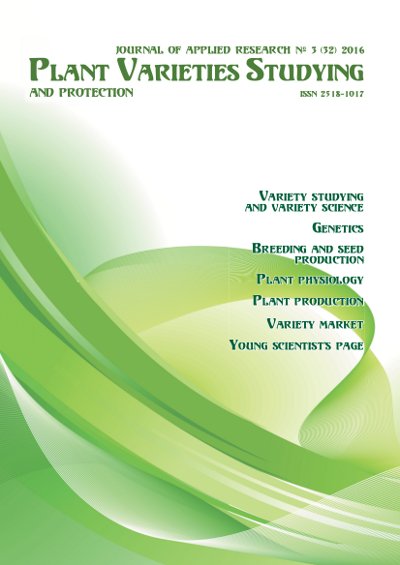Biological peculiarities of stem softwood cuttings of ornamental garden plants and their use in landscaping
DOI:
https://doi.org/10.21498/2518-1017.3(32).2016.75989Keywords:
species, family, root formation, part of a shoot, biologically active substance (KANO), completion of growingAbstract
Purpose. To study biological peculiarities of softwood cuttings of three species of ornamental garden plants of the Hydrangeaceae family introduced under the conditions of a botanical nursery of Uman National University of Horticulture, and the prospects of planting material use in landscaping.
Methods. Field study, laboratory test, statistical and mathematical analysis.
Results. Bioecological and ornamental peculiarities of grafters of investigated species and their preservation for supplying the store of initial plant graft material were studied. The dependence of regeneration ability of softwood cuttings of investigated varieties on preplant treatment by a biologically active substance (KANO), type of a shoot, time of grafting, etc was analyzed. Substantially intensive rooting of basal drafts with three nods and less intensive rooting of apical drafts was observed during the whole period of rooting.
Conclusions. The treatment of softwood cuttings with a biologically active substance at the concentration of 10–15 mg/l in the aqueous solution stimulates root formation and activates growth of own root plants. Investigated plant species of Hydrangeaсeae family are promising for landscaping on urbanized areas of various functional use.
Downloads
References
Svystun, O. V., Mamchur, T. V., & Parubok, M. I. (2012). Collectible nursery of Uman NUH and its role in training specialists of landscape gardening. Ahrobiolohiia [Agrobiology], 8, 13–15. [in Ukrainian]
Hryhorenko, A. V. (2013). Project of greenery planting with the use of Hydrangea L. family species on farmland in the village of Leukhy, Illinets district, Vinnytsia region. Materialy vseukrainskoi naukovoi konferentsii molodykh uchenykh (do 60-richchia utvorennia Cherkaskoi oblasti) [Proceedings of the All-Ukrainian scientific conf. of young scientists (devoted to the 60th anniversary of Cherkasy Oblast establishment], (Vol. 1, pp. 152–158), December 6, Uman, Ukraine: RVV UNUS. [in Ukrainian]
Mykolaiko, I. I. (2013). Risogenetic ability of green stem drafts of a sea buckthorn (Hippohae rhamnoides L.). Naukovyi visnyk Natsionalnoho lisotekhnichnoho universytetu Ukrainy. Aktualni problemy lisovoho ta sadovo-parkovoho hospodarstva [Scientific Bulletin of Ukrainian National Forestry University. Current issues of the development of forestry and landscape gardening], 23.5, 369–376. [in Ukrainian]
Tarasenko, M. T. (1991). Zelenoe cherenkovanie sadovykh i lesnykh kul’tur [Softwood cuttings of garden and forest crops]. Moscow: Izd-vo MSKhA. [in Russian]
Koval, S. A. (2013). Peculiarities of growing of planting material of garden and forest species using stem cuttings. Aktualni problemy rozvytku lisovoho i sadovo-parkovoho hospodarstva: tezy Mizhnarodnoho naukovoho kafedralnoho seminaru [Current issues of the development of forestry and landscape gardening: Abstracts of the Int. Sci. Departmental Seminar] (pp. 36–40). Febuary 16–17, 2013, Uman, Ukraine: RVV UNUS. [in Ukrainian]
Mamchur, T. V. (2015). Improvement of growing nurslings of ornamental garden plants by sowtwood cuttings and their use in greenery planting. Aktualni problemy sadovo-parkovoho mystetstva: materialy Mizhnarodnoi naukovoi konferentsii [Current Issues of Garden Art: Proc. Int. Sci Conf.] (рр. 105–108). May 27–28, 2015, Uman, Ukraine: VPTs “Vizavi”. [in Ukrainian]
Dospekhov, B. A. (1985). Metodika polevogo opyta (s osnovami statisticheskoy obrabotki rezul’tatov issledovaniy) [Methods of field experiment (with the basics of statistical processing of research results)]. (5nd ed., rev.). Moscow: Agropromizdat. [in Russian]
Downloads
Published
How to Cite
Issue
Section
License
Copyright (c) 2016 Ukrainian Institute for Plant Variety Examination

This work is licensed under a Creative Commons Attribution-ShareAlike 4.0 International License.
Starting in 2022, the copyright to the publication remains with the authors
Our journal abides by the CREATIVE COMMONS copyright rights and permissions for open access journals.
Authors, who are published in this journal, agree to the following conditions:
- The authors reserve the right to authorship of the work and pass the first publication right of this work to the journal under the terms of a Creative Commons Attribution License, which allows others to freely distribute the published research with the obligatory reference to the authors of the original work and the first publication of the work in this journal.
- The authors have the right to conclude separate supplement agreements that relate to non-exclusive work distribution in the form in which it has been published by the journal (for example, to upload the work to the online storage of the journal or publish it as part of a monograph), provided that the reference to the first publication of the work in this journal is included.

























 Ukrainian Institute for Plant Varieties Examination
Ukrainian Institute for Plant Varieties Examination  Селекційно-генетичний інститут
Селекційно-генетичний інститут Institute of Plant Physiology and Genetics of the National Academy of Sciences of Ukraine
Institute of Plant Physiology and Genetics of the National Academy of Sciences of Ukraine
 The National Academy of Agrarian Sciences of Ukraine
The National Academy of Agrarian Sciences of Ukraine